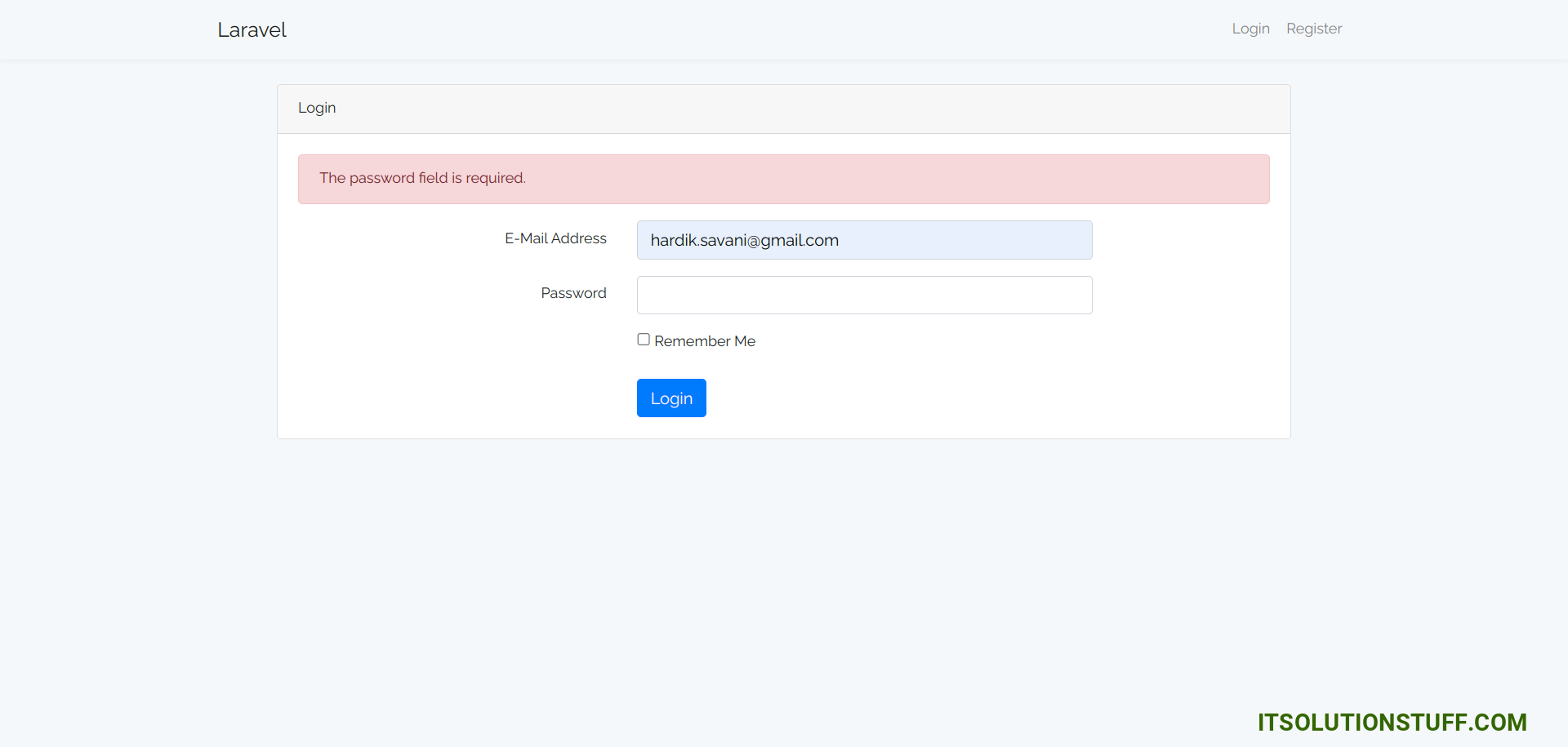Laravel Login and Registration using Ajax Tutorial
Hey Developer,
Today, I will let you know example of laravel ajax login and register. I explained simply about laravel custom login and registration with ajax. you will learn laravel custom login with ajax. We will look at an example of laravel authentication with ajax.
Laravel provides auth using jetstream and UI package. but If you need to create your own login and registration form using ajax, without page reloading then I will help you how to create step by step custom login and registration page in laravel application. you can easily create custom login and registration with laravel 6, laravel 7, laravel 8, laravel 9, laravel 10 and laravel 11 version.
Step 1: Install Laravel
first of all, we need to get a fresh Laravel version application using the bellow command, So open your terminal OR command prompt and run the bellow command:
composer create-project laravel/laravel example-app
Step 2: Database Configuration
In this step, we need to add database configuration in .env file. so let's add the following details and then run the migration command:
.env
DB_CONNECTION=mysql
DB_HOST=127.0.0.1
DB_PORT=3306
DB_DATABASE=laravel9_blog
DB_USERNAME=root
DB_PASSWORD=password
Next, run migration command to create users table.
php artisan migrate
Step 3: Create Route
In this is step we need to create custom route for login, register, home and logout. so open your routes/web.php file and add following route.
routes/web.php
<?php
use Illuminate\Support\Facades\Route;
use App\Http\Controllers\Auth\AuthController;
/*
|--------------------------------------------------------------------------
| Web Routes
|--------------------------------------------------------------------------
|
| Here is where you can register web routes for your application. These
| routes are loaded by the RouteServiceProvider within a group which
| contains the "web" middleware group. Now create something great!
|
*/
Route::get('/', function () {
return view('welcome');
});
Route::get('login', [AuthController::class, 'index'])->name('login');
Route::post('post-login', [AuthController::class, 'postLogin'])->name('login.post');
Route::get('registration', [AuthController::class, 'registration'])->name('register');
Route::post('post-registration', [AuthController::class, 'postRegistration'])->name('register.post');
Route::get('dashboard', [AuthController::class, 'dashboard']);
Route::get('logout', [AuthController::class, 'logout'])->name('logout');
Step 4: Create Controller
in this step, we need to create AuthController and add following code on that file:
app/Http/Controllers/Auth/AuthController.php
<?php
namespace App\Http\Controllers\Auth;
use App\Http\Controllers\Controller;
use Illuminate\Http\Request;
use Illuminate\Support\Facades\Auth;
use Illuminate\Support\Facades\Validator;
use Session;
use App\Models\User;
use Hash;
class AuthController extends Controller
{
/**
* Write code on Method
*
* @return response()
*/
public function index()
{
return view('auth.login');
}
/**
* Write code on Method
*
* @return response()
*/
public function registration()
{
return view('auth.register');
}
/**
* Write code on Method
*
* @return response()
*/
public function postLogin(Request $request)
{
$validator = Validator::make($request->all(), [
'email' => 'required|email',
'password' => 'required'
]);
if ($validator->fails()){
return response()->json([
"status" => false,
"errors" => $validator->errors()
]);
} else {
if (Auth::attempt($request->only(["email", "password"]))) {
return response()->json([
"status" => true,
"redirect" => url("dashboard")
]);
} else {
return response()->json([
"status" => false,
"errors" => ["Invalid credentials"]
]);
}
}
}
/**
* Write code on Method
*
* @return response()
*/
public function postRegistration(Request $request)
{
$validator = Validator::make($request->all(), [
'name' => 'required',
'email' => 'required|email|unique:users',
'password' => 'required|min:6',
'confirm_password' => 'required|min:6|same:password',
]);
if ($validator->fails()){
return response()->json([
"status" => false,
"errors" => $validator->errors()
]);
}
$data = $request->all();
$user = $this->create($data);
Auth::login($user);
return response()->json([
"status" => true,
"redirect" => url("dashboard")
]);
}
/**
* Write code on Method
*
* @return response()
*/
public function dashboard()
{
if(Auth::check()){
return view('dashboard');
}
return redirect("login")->withSuccess('Opps! You do not have access');
}
/**
* Write code on Method
*
* @return response()
*/
public function create(array $data)
{
return User::create([
'name' => $data['name'],
'email' => $data['email'],
'password' => Hash::make($data['password'])
]);
}
/**
* Write code on Method
*
* @return response()
*/
public function logout() {
Session::flush();
Auth::logout();
return Redirect('login');
}
}
Step 5: Create Blade Files
here, we need to create blade files for layout, login, register and home page. so let's create one by one files:
resources/views/auth/login.blade.php
@extends('layout')
@section('content')
<main class="login-form">
<div class="cotainer">
<div class="row justify-content-center">
<div class="col-md-8">
<div class="card">
<div class="card-header">Login</div>
<div class="card-body">
<form action="{{ route('login.post') }}" method="POST" id="handleAjax">
@csrf
<div id="errors-list"></div>
<div class="form-group row">
<label for="email_address" class="col-md-4 col-form-label text-md-right">E-Mail Address</label>
<div class="col-md-6">
<input type="text" id="email_address" class="form-control" name="email" required autofocus>
@if ($errors->has('email'))
<span class="text-danger">{{ $errors->first('email') }}</span>
@endif
</div>
</div>
<div class="form-group row">
<label for="password" class="col-md-4 col-form-label text-md-right">Password</label>
<div class="col-md-6">
<input type="password" id="password" class="form-control" name="password">
@if ($errors->has('password'))
<span class="text-danger">{{ $errors->first('password') }}</span>
@endif
</div>
</div>
<div class="form-group row">
<div class="col-md-6 offset-md-4">
<div class="checkbox">
<label>
<input type="checkbox" name="remember"> Remember Me
</label>
</div>
</div>
</div>
<div class="col-md-6 offset-md-4">
<button type="submit" class="btn btn-primary">
Login
</button>
</div>
</form>
</div>
</div>
</div>
</div>
</div>
</main>
<script type="text/javascript">
$(function() {
/*------------------------------------------
--------------------------------------------
Submit Event
--------------------------------------------
--------------------------------------------*/
$(document).on("submit", "#handleAjax", function() {
var e = this;
$(this).find("[type='submit']").html("Login...");
$.ajax({
url: $(this).attr('action'),
data: $(this).serialize(),
type: "POST",
dataType: 'json',
success: function (data) {
$(e).find("[type='submit']").html("Login");
if (data.status) {
window.location = data.redirect;
}else{
$(".alert").remove();
$.each(data.errors, function (key, val) {
$("#errors-list").append("<div class='alert alert-danger'>" + val + "</div>");
});
}
}
});
return false;
});
});
</script>
@endsection
resources/views/auth/register.blade.php
@extends('layout')
@section('content')
<main class="login-form">
<div class="cotainer">
<div class="row justify-content-center">
<div class="col-md-8">
<div class="card">
<div class="card-header">Register</div>
<div class="card-body">
<form action="{{ route('register.post') }}" method="POST" id="handleAjax">
@csrf
<div id="errors-list"></div>
<div class="form-group row">
<label for="name" class="col-md-4 col-form-label text-md-right">Name</label>
<div class="col-md-6">
<input type="text" id="name" class="form-control" name="name" required autofocus>
@if ($errors->has('name'))
<span class="text-danger">{{ $errors->first('name') }}</span>
@endif
</div>
</div>
<div class="form-group row">
<label for="email_address" class="col-md-4 col-form-label text-md-right">E-Mail Address</label>
<div class="col-md-6">
<input type="text" id="email_address" class="form-control" name="email" required autofocus>
@if ($errors->has('email'))
<span class="text-danger">{{ $errors->first('email') }}</span>
@endif
</div>
</div>
<div class="form-group row">
<label for="password" class="col-md-4 col-form-label text-md-right">Password</label>
<div class="col-md-6">
<input type="password" id="password" class="form-control" name="password" required>
@if ($errors->has('password'))
<span class="text-danger">{{ $errors->first('password') }}</span>
@endif
</div>
</div>
<div class="form-group row">
<label for="confirm_password" class="col-md-4 col-form-label text-md-right">Confirm Password</label>
<div class="col-md-6">
<input type="password" id="confirm_password" class="form-control" name="confirm_password" required>
@if ($errors->has('confirm_password'))
<span class="text-danger">{{ $errors->first('confirm_password') }}</span>
@endif
</div>
</div>
<div class="form-group row">
<div class="col-md-6 offset-md-4">
<div class="checkbox">
<label>
<input type="checkbox" name="remember"> Remember Me
</label>
</div>
</div>
</div>
<div class="col-md-6 offset-md-4">
<button type="submit" class="btn btn-primary">
Register
</button>
</div>
</form>
</div>
</div>
</div>
</div>
</div>
</main>
<script type="text/javascript">
$(function() {
/*------------------------------------------
--------------------------------------------
Submit Event
--------------------------------------------
--------------------------------------------*/
$(document).on("submit", "#handleAjax", function() {
var e = this;
$(this).find("[type='submit']").html("Register...");
$.ajax({
url: $(this).attr('action'),
data: $(this).serialize(),
type: "POST",
dataType: 'json',
success: function (data) {
$(e).find("[type='submit']").html("Register");
if (data.status) {
window.location = data.redirect;
}else{
$(".alert").remove();
$.each(data.errors, function (key, val) {
$("#errors-list").append("<div class='alert alert-danger'>" + val + "</div>");
});
}
}
});
return false;
});
});
</script>
@endsection
resources/views/dashboard.blade.php
@extends('layout')
@section('content')
<div class="container">
<div class="row justify-content-center">
<div class="col-md-8">
<div class="card">
<div class="card-header">{{ __('Dashboard') }}</div>
<div class="card-body">
@if (session('success'))
<div class="alert alert-success" role="alert">
{{ session('success') }}
</div>
@endif
You are Logged In
</div>
</div>
</div>
</div>
</div>
@endsection
resources/views/layout.blade.php
<!DOCTYPE html>
<html>
<head>
<title>Laravel - ItSolutionStuff.com</title>
<link rel="stylesheet" href="https://stackpath.bootstrapcdn.com/bootstrap/4.1.3/css/bootstrap.min.css">
<style type="text/css">
@import url(https://fonts.googleapis.com/css?family=Raleway:300,400,600);
body{
margin: 0;
font-size: .9rem;
font-weight: 400;
line-height: 1.6;
color: #212529;
text-align: left;
background-color: #f5f8fa;
}
.navbar-laravel
{
box-shadow: 0 2px 4px rgba(0,0,0,.04);
}
.navbar-brand , .nav-link, .my-form, .login-form
{
font-family: Raleway, sans-serif;
}
.my-form
{
padding-top: 1.5rem;
padding-bottom: 1.5rem;
}
.my-form .row
{
margin-left: 0;
margin-right: 0;
}
.login-form
{
padding-top: 1.5rem;
padding-bottom: 1.5rem;
}
.login-form .row
{
margin-left: 0;
margin-right: 0;
}
</style>
</head>
<body>
<nav class="navbar navbar-expand-lg navbar-light navbar-laravel">
<div class="container">
<a class="navbar-brand" href="#">Laravel</a>
<button class="navbar-toggler" type="button" data-toggle="collapse" data-target="#navbarSupportedContent" aria-controls="navbarSupportedContent" aria-expanded="false" aria-label="Toggle navigation">
<span class="navbar-toggler-icon"></span>
</button>
<div class="collapse navbar-collapse" id="navbarSupportedContent">
<ul class="navbar-nav ml-auto">
@guest
<li class="nav-item">
<a class="nav-link" href="{{ route('login') }}">Login</a>
</li>
<li class="nav-item">
<a class="nav-link" href="{{ route('register') }}">Register</a>
</li>
@else
<li class="nav-item">
<a class="nav-link" href="{{ route('logout') }}">Logout</a>
</li>
@endguest
</ul>
</div>
</div>
</nav>
@yield('content')
</body>
</html>
Run Laravel App:
All the required steps have been done, now you have to type the given below command and hit enter to run the Laravel app:
php artisan serve
Now, Go to your web browser, type the given URL and view the app output:
http://localhost:8000/login
Output:

I hope it can help you...

